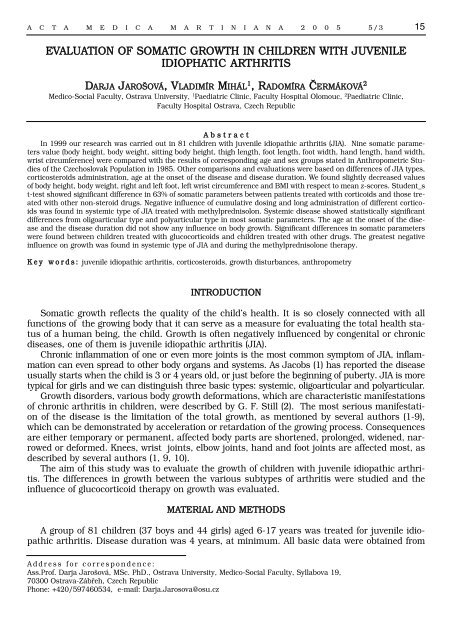MAKETA 5/3
MAKETA 5/3
MAKETA 5/3
Create successful ePaper yourself
Turn your PDF publications into a flip-book with our unique Google optimized e-Paper software.
A C T A M E D I C A M A R T I N I A N A 2 0 0 5 5/3 15<br />
EVALUATION OF SOMATIC GROWTH IN CHILDREN WITH JUVENILE<br />
IDIOPHATIC ARTHRITIS<br />
DARJA JAROŠOVÁ, VLADIMÍR MIHÁL 1 , RADOMÍRA ČERMÁKOVÁ 2<br />
Medico-Social Faculty, Ostrava University, 1 Paediatric Clinic, Faculty Hospital Olomouc, 2 Paediatric Clinic,<br />
Faculty Hospital Ostrava, Czech Republic<br />
A b s t r a c t<br />
In 1999 our research was carried out in 81 children with juvenile idiopathic arthritis (JIA). Nine somatic parameters<br />
value (body height, body weight, sitting body height, thigh length, foot length, foot width, hand length, hand width,<br />
wrist circumference) were compared with the results of corresponding age and sex groups stated in Anthropometric Studies<br />
of the Czechoslovak Population in 1985. Other comparisons and evaluations were based on differences of JIA types,<br />
corticosteroids administration, age at the onset of the disease and disease duration. We found slightly decreased values<br />
of body height, body weight, right and left foot, left wrist circumference and BMI with respect to mean z-scores. Student_s<br />
t-test showed significant difference in 63% of somatic parameters between patients treated with corticoids and those treated<br />
with other non-steroid drugs. Negative influence of cumulative dosing and long administration of different corticoids<br />
was found in systemic type of JIA treated with methylprednisolon. Systemic disease showed statistically significant<br />
differences from oligoarticular type and polyarticular type in most somatic parameters. The age at the onset of the disease<br />
and the disease duration did not show any influence on body growth. Significant differences in somatic parameters<br />
were found between children treated with glucocorticoids and children treated with other drugs. The greatest negative<br />
influence on growth was found in systemic type of JIA and during the methylprednisolone therapy.<br />
K e y w o r d s : juvenile idiopathic arthritis, corticosteroids, growth disturbances, anthropometry<br />
INTRODUCTION<br />
Somatic growth reflects the quality of the child’s health. It is so closely connected with all<br />
functions of the growing body that it can serve as a measure for evaluating the total health status<br />
of a human being, the child. Growth is often negatively influenced by congenital or chronic<br />
diseases, one of them is juvenile idiopathic arthritis (JIA).<br />
Chronic inflammation of one or even more joints is the most common symptom of JIA, inflammation<br />
can even spread to other body organs and systems. As Jacobs (1) has reported the disease<br />
usually starts when the child is 3 or 4 years old, or just before the beginning of puberty. JIA is more<br />
typical for girls and we can distinguish three basic types: systemic, oligoarticular and polyarticular.<br />
Growth disorders, various body growth deformations, which are characteristic manifestations<br />
of chronic arthritis in children, were described by G. F. Still (2). The most serious manifestation<br />
of the disease is the limitation of the total growth, as mentioned by several authors (1-9),<br />
which can be demonstrated by acceleration or retardation of the growing process. Consequences<br />
are either temporary or permanent, affected body parts are shortened, prolonged, widened, narrowed<br />
or deformed. Knees, wrist joints, elbow joints, hand and foot joints are affected most, as<br />
described by several authors (1, 9, 10).<br />
The aim of this study was to evaluate the growth of children with juvenile idiopathic arthritis.<br />
The differences in growth between the various subtypes of arthritis were studied and the<br />
influence of glucocorticoid therapy on growth was evaluated.<br />
MATERIAL AND METHODS<br />
A group of 81 children (37 boys and 44 girls) aged 6-17 years was treated for juvenile idiopathic<br />
arthritis. Disease duration was 4 years, at minimum. All basic data were obtained from<br />
Address for correspondence:<br />
Ass.Prof. Darja Jarošová, MSc. PhD., Ostrava University, Medico-Social Faculty, Syllabova 19,<br />
70300 Ostrava-Zábřeh, Czech Republic<br />
Phone: +420/597460534, e-mail: Darja.Jarosova@osu.cz
















